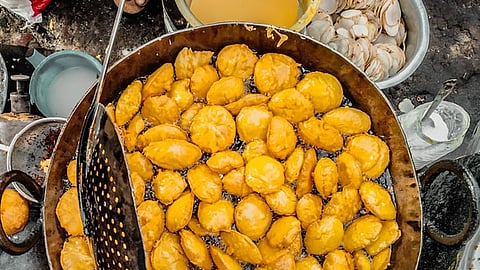
- Home
- EventsEvents
- Product Launches
- CategoriesCategories
- Advertise
- Opinion

Photo - sudarshan poojary on Unsplash
Oil is essential for all cuisines. No cuisine is complete without using oils, and especially Indian cooking is indispensable without cooking oil. Consumption of oil correctly often doesn’t cause any health issues; however, using the right oil in the right way is extremely important. Though many people in domestic usage and industries follow good cooking practices regularly, very few people are aware of the dangerous effects of recycled cooking oil that is re-heating the used oil.
For safety and quality, it is recommended to use fresh cooking oil each time you fry. However, if you deep-fry large amounts of food frequently, it is not always practical from an economic point of view. Food industries, hotels, restaurants which use large quantities of oils for frying snacks and savories face this crisis.
Smoke point
Moreover, it is important to know the chemistry of oil heating to understand this fact better. Every oil has a different temperature at which it starts to break down and smoke - known as the smoke point. In general, refined oils have higher smoke points than unrefined. Each time the oil is heated, its smoke point drops. Hence with each use, the oil keeps on becoming more and more unsafe.
Total Polar Compounds
Some reactions in oil molecules modify the chemical composition of the used oil, releasing free fatty acids and radicals called Total Polar Compounds, a reliable benchmark for measuring the degradation of cooking oil.
According to FSSAI (Food Safety and Standards Authority of India) guidelines, re-heating should be avoided. If you have to reuse the oil, a maximum of three times is permitted to prevent the formation of trans-fats. Also, when reusing vegetable oil, the total developed Total Polar Compounds of more than 25% should not be used.
Ways to reduce wastage & prevent harmful effects of re-heating oils
Regulate the heating temperature - The first way is to regulate the heating temperature. Keeping in mind the smoke point of a particular oil, the heating should always be below that temperature. Industries should practice regular monitoring of temperature using food/cooking thermometer. For domestic usage keeping the oil temperature below smoke point can be done by regular visual checks and manual temperature settings.
Use oils with higher smoke points for deep frying - Another possible solution is to use oils with higher smoke points, making them suitable for deep frying. Examples of such oils are sunflower oil, soybean oil, rice bran, peanut, sesame, mustard, and canola oil. Oils that do not have a high smoke point like extra virgin olive oil or flaxseed oil. These oils should not be used for high heat cooking, and they are best used in cold salads, smoothies, or max for sautéing at not very high temperatures or for long durations.
Avoid adding salt or seasoning - Not adding salt to the food before frying is a good way to maintain the cooking temperature. Due to its osmotic properties, salt lowers the smoke point of oil and thus makes it more prone to spoil at a lower temperature than usual. So, adding salt or seasonings post-cooking is most desirable as far as possible.
Proper storage of oils - If oil has to be reused, one should ensure adequate storage of oils. Once the used oil cools down to room temperature, ensure appropriately strained to remove any food particles. This helps in preventing more oxidative damage to oils and also prevents bacteria build up on food particles. It should be stored in a clean glass container till subsequent usage. Food industries can also store this safely under deep refrigeration, which can help in increasing its shelf life further.
Avoid mixing of used & fresh oils - Used and fresh oil should never be mixed. When reusing an oil once, inspect various things like odor, color, viscosity, presence of foam. If the oil looks darker, is very thick, or smells like the food that you earlier cooked in it, then these are warning signs to avoid using the oil again. If on re-heating the oil once can see white foam, bubbles then this oil should be discarded as it may contain HNE (4-hydroxy-trans-2-nonenal) a highly toxic residue.
It is important to regulate the reuse of edible oil to help domestic consumers and food industries and large eateries from the ill effects of re-heated cooking oil. Regulations from the government and food agencies have a huge role to play in this. The wastage and ill effects of these oils is so huge that the Indian Biodiesel Association has been asked by the FSSAI (Food Safety and Standards Authority of India) to create a nationwide eco-system to collect used cooking oil to convert it into bio-diesel!
Arooshi Garg is expert coach at GOQii
